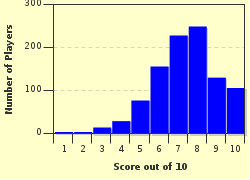Quiz Answer Key and Fun Facts
1. In which granary of the Roman Empire was a cat considered holy?
2. In which Flemish city, notorious as one of the most bombarded cities during the First World War, is there a tradition of throwing cats from the belfry? Nowadays they use puppet cats, of course.
3. What was the name of the "First Cat" taken as a pet by President Clinton and his family?
4. What is the nickname of the jet fighter F14?
5. Which of the following events did NOT take place in "the year of the cat"?
6. In Sikhism, all men receive the last name "Singh". What does this name mean?
7. In which war did the German army fight battles using Panthers and Tigers?
8. In the Maya culture, there were several animals protected by some gods. Which goddess looked after the jaguars? As this is a very difficult question, I'll hint that the correct answer counts six letters.
9. Which carnivorous marsupial has been extinct since the twentieth century and was last sighted in Australia in 1936?
10. 'Cat' is also short for 'Catherine'. Which of these 'Cats' does not belong?
Source: Author
JanIQ
This quiz was reviewed by FunTrivia editor
bloomsby before going online.
Any errors found in FunTrivia content are routinely corrected through our feedback system.


